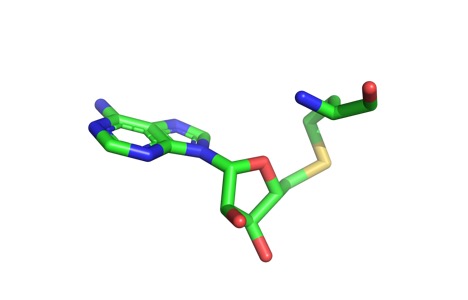User:Lauryn Padgett/Sandbox 1
From Proteopedia
(Difference between revisions)
| Line 9: | Line 9: | ||
===Overall Secondary Structure=== | ===Overall Secondary Structure=== | ||
| - | + | Due to the composition of its [https://en.wikipedia.org/wiki/Protein_secondary_structure secondary structure], KMT is an alpha-beta protein . The helical composition includes 3 <scene name='81/811086/Alpha_helices/4'>alpha helices</scene>, with two residing in the SET domain and one in the C-terminal domain. The alpha helices in the SET domain are two turns while the C-terminal helix is by far the largest with 4 turns. There are also 2 <scene name='81/811086/3-10_helices/4'>3-10 helices</scene> in the SET domain which are each one turn. There are 21 total <scene name='81/811086/Beta_sheets/3'>beta strands</scene> which reside in the N-terminal domain and the SET domain. The beta strands are primarily anti-parallel and multiple antiparallel strands are connected by <scene name='81/811086/Type_i_beta_turns/3'>Type I</scene> and <scene name='81/811086/Type_ii_beta_turns/2'>Type II</scene> beta turns. | |
| + | |||
The <scene name='81/811091/C_terminal_domain/1'>C-terminal Domain</scene> of the protein is essential for the binding and stabilization of the cofactor. The | The <scene name='81/811091/C_terminal_domain/1'>C-terminal Domain</scene> of the protein is essential for the binding and stabilization of the cofactor. The | ||
| Line 32: | Line 33: | ||
==Inhibitor== | ==Inhibitor== | ||
| - | Sinefungin is a potent methyltransferase inhibitor. | + | Sinefungin is a potent methyltransferase inhibitor that is a natural nucleoside isolated from the ''Streptomyces'' species. Also referred to as adenosyl-ornithine, it is the delta (5’ adenosyl) derivative of ornithine and a structural analog of S-adenosylmethionine. Sinefungin is more stable bound in the active site than SAM due to the ability to create two additional hydrogen bonds to its amine group that are not possible with SAM’s sulfur. |
| + | Sinefungin has been used experimentally to inhibit the SET 7/9 protein on peritoneal fibrosis in mice and in human peritoneal mesothelial cells (cite tamura). SET 7/9 is involved in peritoneal fibrosis because it mono-methylates H3K4, which activates the transcription of fibrosis related genes. The administration of Sinefungin to mice correlated with decreasing levels of methylated H3K4 (H3K4me1) protein, as well as suppressed cell accumulation and thickening in methylglyoxial peritoneal fibrosis. The decreased levels of H3K4me1 suggest that the methylation of H3K4 was inhibited by Sinefungin. | ||
Revision as of 00:45, 25 April 2019
Homo sapiens Histone Methyl Transferase SET7/9 (KMT)==
| |||||||||||
References
- ↑ Hanson, R. M., Prilusky, J., Renjian, Z., Nakane, T. and Sussman, J. L. (2013), JSmol and the Next-Generation Web-Based Representation of 3D Molecular Structure as Applied to Proteopedia. Isr. J. Chem., 53:207-216. doi:http://dx.doi.org/10.1002/ijch.201300024
- ↑ Herraez A. Biomolecules in the computer: Jmol to the rescue. Biochem Mol Biol Educ. 2006 Jul;34(4):255-61. doi: 10.1002/bmb.2006.494034042644. PMID:21638687 doi:10.1002/bmb.2006.494034042644
Schluckebier et al. (1997), Differential binding of S-andeosylmethionine S-adenosylhomocysteine and Sinefungin to adenine-specific DNA methyltransferase M. TaqI; J. Mol. Biol., 265 56

